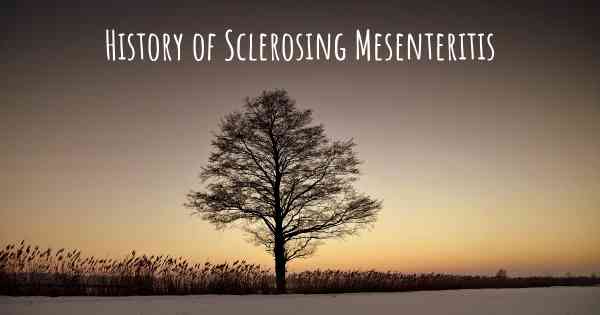What is the history of Sclerosing Mesenteritis?
When was Sclerosing Mesenteritis discovered? What is the story of this discovery? Was it coincidence or not?

Sclerosing mesenteritis is a rare and chronic inflammatory condition that affects the mesentery, a fold of tissue that attaches the intestines to the abdominal wall. It is characterized by the inflammation and fibrosis (scarring) of the mesenteric adipose tissue, which can lead to various symptoms and complications. The exact cause of sclerosing mesenteritis is still unknown, and it is often considered an idiopathic condition.
The history of sclerosing mesenteritis dates back to the early 20th century when it was first described by Jura in 1924 as "mesenteric panniculitis." However, it was not until 1949 that Ogilvie coined the term "sclerosing mesenteritis" to better describe the fibrotic nature of the disease.
Over the years, the understanding of sclerosing mesenteritis has evolved, and several terms have been used interchangeably to describe the condition, including retractile mesenteritis, mesenteric lipodystrophy, and mesenteric Weber-Christian disease. These terms reflect the different aspects of the disease and the various theories proposed to explain its pathogenesis.
The pathogenesis of sclerosing mesenteritis remains unclear, and several theories have been proposed to explain its development. One theory suggests that it is an autoimmune disorder, as some patients with sclerosing mesenteritis have autoantibodies present in their blood. Another theory suggests that it may be a reactive process to an underlying infection or inflammation. However, none of these theories have been definitively proven, and the exact cause of the disease remains unknown.
Sclerosing mesenteritis primarily affects middle-aged and older adults, with a slight male predominance. It is a rare condition, and its true prevalence is difficult to determine due to its often asymptomatic nature. The disease can present with a wide range of symptoms, making it challenging to diagnose. Common symptoms include abdominal pain, bloating, nausea, vomiting, weight loss, and changes in bowel habits. In some cases, the disease may be discovered incidentally during imaging studies or surgery.
Diagnosing sclerosing mesenteritis can be challenging due to its nonspecific symptoms and the lack of specific diagnostic tests. The diagnosis is usually made based on a combination of clinical presentation, imaging studies, and histopathological examination. Imaging techniques such as computed tomography (CT) scans and magnetic resonance imaging (MRI) can help visualize the characteristic features of sclerosing mesenteritis, including the presence of a soft tissue mass or a fibrotic plaque in the mesentery. However, these findings are not specific to the disease and can be seen in other conditions as well.
Histopathological examination of a biopsy sample obtained during surgery or image-guided biopsy is often necessary to confirm the diagnosis. The characteristic histological features of sclerosing mesenteritis include chronic inflammation, fibrosis, and the presence of fat necrosis. However, these findings can also be seen in other conditions, making the diagnosis challenging.
The treatment of sclerosing mesenteritis is primarily supportive and aimed at managing symptoms and complications. In many cases, the disease is self-limiting and may not require specific treatment. However, in symptomatic cases, various treatment options have been used with varying success. Nonsteroidal anti-inflammatory drugs (NSAIDs) and corticosteroids have been used to reduce inflammation and alleviate symptoms. Immunosuppressive agents such as azathioprine and methotrexate have also been used in refractory cases. Surgical intervention may be necessary in cases with complications such as bowel obstruction or perforation.
In conclusion, sclerosing mesenteritis is a rare and chronic inflammatory condition that primarily affects the mesentery. Its exact cause is unknown, and it is often considered an idiopathic disease. The understanding of sclerosing mesenteritis has evolved over the years, and several terms have been used to describe the condition. Diagnosing the disease can be challenging due to its nonspecific symptoms and lack of specific diagnostic tests. Treatment is primarily supportive and aimed at managing symptoms and complications. Further research is needed to better understand the pathogenesis of the disease and develop more effective treatment strategies.








